Keeping fish is an extremely popular hobby. In fact, did you know that roughly 139 million fish are kept in US home aquariums? And that’s just freshwater fish; many millions more live in saltwater and brackish tanks.
If you’re thinking of getting a fish tank, but you can’t decide what kind of setup to go for, you need to read this guide!
In this article, we give an overview of the different types of fishkeeping systems you could choose and explain what setting up and maintaining each of them involves.
Freshwater Aquarium System
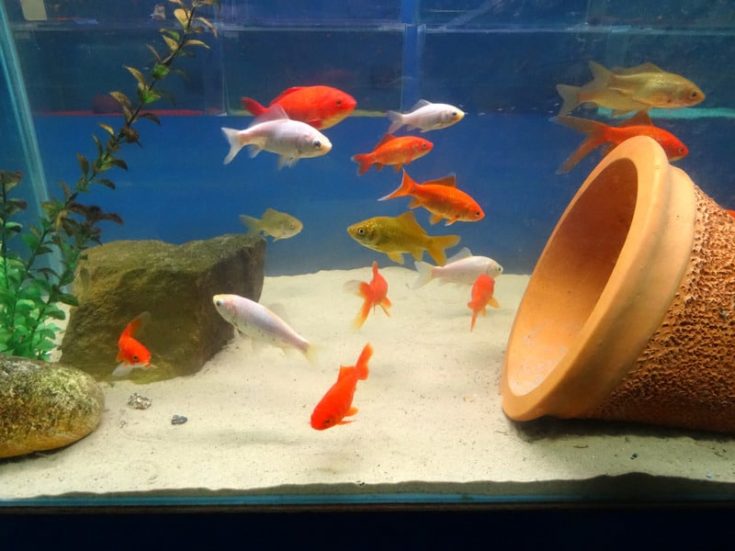
The most popular fishkeeping system is the freshwater system.
Freshwater fish tanks are cheaper to set up than marine aquariums, the fish are generally less expensive to buy, and there are dozens of different aquatic plant species that you can use to aquascape your tank.
Definition
A freshwater aquarium is defined as a tank that contains freshwater aquatic creatures, including fish, invertebrates, crustaceans, and amphibians.
You can keep tropical or coldwater species in a freshwater tank, and your setup could contain a community of peaceful, compatible fish or be a single-species aquarium for one aggressive or semi-aggressive fish species.
Water Parameters
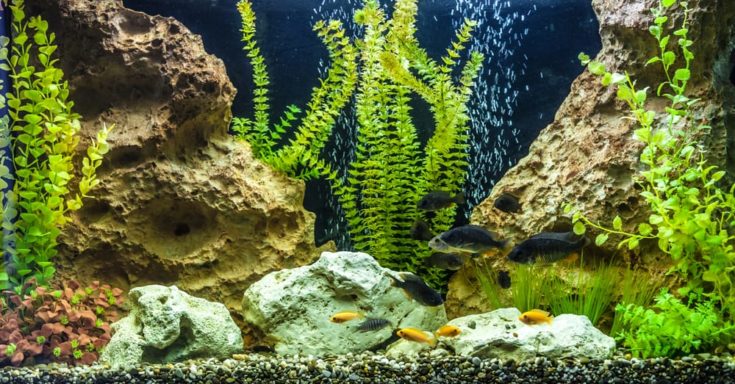
The water parameters in a freshwater tank vary widely between species.
The pH range can be anywhere from 6.0 to 8.5 and general water hardness from 4 to 20 GH.
However, in any freshwater setup, the levels of ammonia and nitrite should be zero, and nitrates should ideally be below 20ppm.
Water Temperature
The water temperature in a freshwater aquarium system depends on the requirements of the species of fish and other critters you’re keeping.
Tropical Aquariums
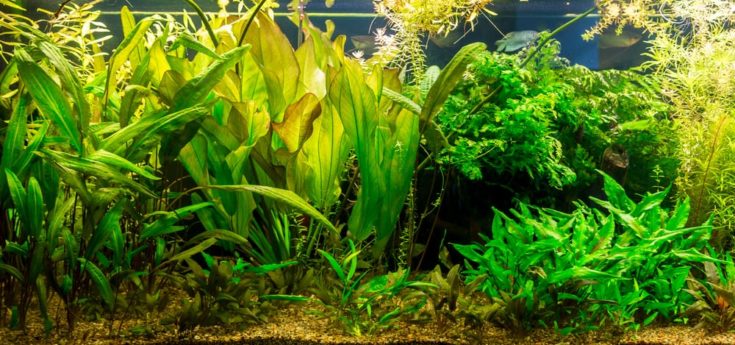
A good range of temperature for a tropical fish tank is between 76° to 80°F.
However, there are a few species that need slightly warmer temperatures and some that require a few degrees cooler than that. So, you should always double-check the requirements of the fish species you want to keep. Temperature shock and the stress it causes is a major killer of pet fish, so you must ensure that the water temperature in your fish tank is suitable for your fish.
Most high-quality aquarium heaters have a calibration facility that allows you to set the water temperature you want for your fish. However, I advise you to invest in a good aquarium thermometer so that you can monitor the temperature every day. That will alert you to a heater failure, which could save your fish.
Coldwater Aquariums
Cool water fishes, such as goldfish, need a cooler water temperature than tropical species. Most coldwater fish are happy when kept in a tank with a temperature between 60° to 75°F. However, a few prefer a temperature of below 70°F.
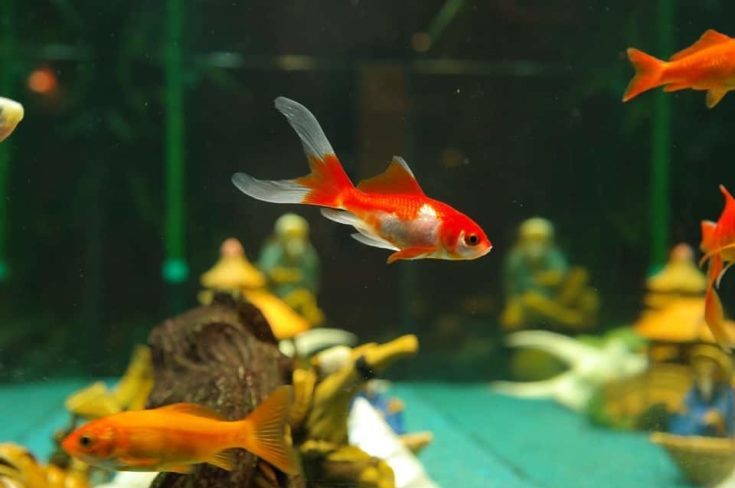
That temperature range generally means that you can keep your fish without the need for a heater. For example, I have a large fancy goldfish tank in my living room, which does fine at room temperature without a heater.
Temperate Aquariums
Some species of fish and plants are classed as “temperate.” That means they can live in both cooler tropical and coldwater tanks. The temperature range for a temperate tank should be between 64° and 71°F.
For example, the Zebra Danio can live in temperate, coldwater, or cooler tropical tanks.
Setting Up Your Freshwater Aquarium System
You can read a detailed guide on how to set up a freshwater fish tank in the article at this link. Meanwhile, here’s a brief overview:
1. Start by washing away any dust and debris from the substrate you’ve chosen.
2. Add a few inches of the substrate to the fish tank. So that the water doesn’t displace the substrate when you fill the tank, put an upturned dish or a flat rock on top of the substrate in the center of the aquarium. When you fill the tank, pour the water over the dish or rock.
3. Install your filtration system and heater. You don’t need to switch them on just yet.
4. Fill the tank using dechlorinated tap water, just under the fill line.
5. You can’t add fish to your tank until the Nitrogen Cycle is complete. For the cycle to begin, the water must contain some ammonia. So, put some fish flakes or some pure ammonia into the tank. You can also use a small quantity of substrate from a mature, cycled tank.
6. Make sure your decorations are free from dust and arrange them in the tank.
7. If you’re using live plants, snip off any dead leaves or broken stems, and then add the plants to the tank.
8. Now, switch on the filter and heater. Your plants will need eight to ten hours of light every day so that they can photosynthesize, so you’ll need to set the timer on your lighting unit.
Now you need to wait for between ten days and six weeks for the tank to fully cycle before you can add any fish. Test the water every day using an aquarium water testing kit to make sure that the water parameters are suitable.
Saltwater Aquarium System Definition
Saltwater aquariums are also commonly referred to as marine tanks.
You can keep marine fish, invertebrates, crustaceans, corals, and anemones in a saltwater tank. Generally, the livestock for a saltwater tank is more expensive to buy than freshwater fish. Also, since many species are wild-caught, their care is more challenging. For that reason, marine tanks are not considered suitable for beginners.
There are several different designs on saltwater aquariums:
Fish-Only Tanks
A fish-only saltwater tank is the least expensive option, although that doesn’t make it the easiest.
Thanks to the absence of plant matter in the environment, it can take longer to establish a proper Nitrogen Cycle, and more frequent maintenance is also necessary when compared to reef tanks. Also, you need to keep a close eye on the water parameters, too.
Fish Only With Live Rock (FOWLR) Aquariums
The basic setup of a FOWLR tank is essentially the same as a fish-only tank but with better lighting and the inclusion of live rock.
Live rock has living creatures both inside it and on the surface, hence its popular name. Live rock provides excellent natural biological filtration. Generally, you need 1.5 pounds of live rock per gallon of water in your aquarium. However, healthy live rock is very expensive.
Reef Tanks
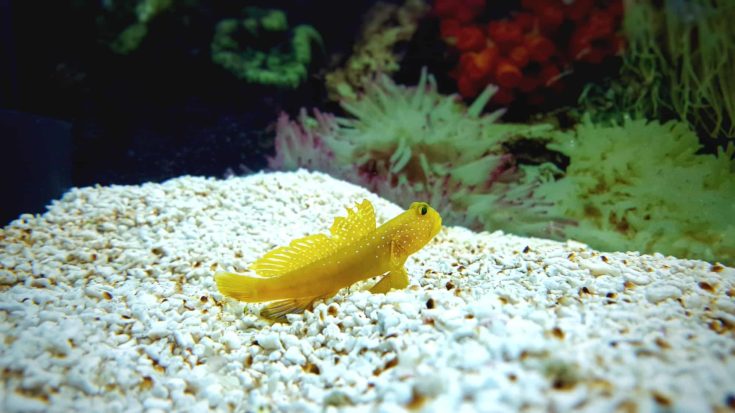
Advanced fishkeepers can set up a tank that contains anemones, corals, and invertebrates. The focus here is more on the anemones and corals rather than fish.
Reef tanks are very expensive to establish, and you need to check the water quality on a daily basis to ensure that the system remains in balance and healthy for your fish. For that reason, I recommend that only experienced saltwater aquarists consider taking on a reef setup.
Water Parameters
The range of water parameters in saltwater tanks is extremely broad, depending on the species of creatures living there. Also, FOWLR tanks have a much broader range of parameters than reef tanks. That’s because of the sensitive, delicate nature of inverts and corals that live in reef aquariums. So, it’s essential that you check each species of critter you’re thinking of taking on before you go ahead and buy anything.
- Specific gravity can range from 1.020 to 1.025.
- pH range is between 8.0 and 8.5
- Alkalinity is from 8 to 12 dKH
- Phosphate < 0.2 ppm to 0.13ppm
- Calcium 350ppm to 450ppm
- Magnesium 1150 to 1350
- Iodine 0.04ppm to .010ppm
- Strontium 4ppm to 14ppm
As with any fish tank, the levels of ammonia and nitrites must be zero, and nitrates should be a maximum of 20ppm.
Water Temperature
Saltwater tanks are generally tropical setups to reflect the warm water ocean environment. Temperatures are usually between 72° and 82°F.
Setting Up Your Saltwater Aquarium System
Before you begin, plan your saltwater tank carefully. Setting up a marine fish-only, FOWLR, or reef tank is a very expensive undertaking, so you need to get it right.
1. Rinse your substrate and add a couple of inches to the tank. You don’t need more than that since you won’t be using live plants unless you’re keeping fish that are burrowers.
2. Now you need to add water. In a marine tank, you should use RO (reverse osmosis) water that you can either buy from a fish store or prepare yourself, using an RO unit. Add aquarium salt to the water, following the directions on the packaging and in accordance with the requirements of your chosen livestock. Finally, add a dechlorinator to the water.
3. Fill the tank to just below the fill line to allow for water displacement when you add rocks and decorations. Pour the water over a flat rock or plate to prevent displacement of your substrate.
4. Install your filtration system, heater, and any other equipment such as a protein skimmer, air stone, UV sterilizer, and lighting unit if you want to use them.
5. Add your decorations, having rinsed off any dust first.
6. Add live rock to the tank to kick off the Nitrogen Cycle. Live rock already contains colonies of beneficial bacteria that should start the cycle. However, if necessary, you might need to add a few drops of pure ammonia.
Test the water every day until levels of ammonia and nitrite are zero and nitrates are at or below 20ppm. Once the levels are acceptable, you can add some fish or inverts.
Brackish Aquarium System
Definition
A brackish system is an aquarium where the water is a mixture of salty and freshwater. Often, brackish environments are found where freshwater streams and river tributaries meet the ocean.
Some fish and invert species can live in either environment, whereas others are brackish water specialists.
Water Parameters
In a brackish tank, the water pH should be between 7.2 and 8.5 with a specific gravity of 1.005 to 1.020, depending on the species you want to keep.
Again, ammonia and nitrites should be zero and nitrates at or below 20ppm.
Water temperatures should be between 73.4° and 84.2°F, again, depending on the variety of fish and other creatures you want to keep.
Setting Up Your Brackish Aquarium System
Essentially, you need the same supplies for a brackish tank as you do for a freshwater setup, except that you need marine salt.
When setting up a brackish aquarium, you must add the salt mixture to a bucket of water and then add it to the tank. Don’t add salt directly into the aquarium, as that can cause serious problems for your plants and fish.
1. Rinse the substrate under running water to get rid of dust and debris.
2. Put a few inches of the substrate in the aquarium. Put an upturned bowl or a flat stone on top of the substrate in the center of the aquarium. Pour the water over the bowl or stone so that it doesn’t scatter the substrate everywhere.
3. Install your filter and heater, but don’t switch them on yet.
4. Wash your ornaments and add them to the tank.
5. Snip away dead or brown leaves and broken stems from living plants and arrange them in the aquarium.
6. Fill a bucket with tap water. Add a dechlorinator and marine salt as per the manufacturer’s directions. Make sure the salt has dissolved before adding the water to the tank. Check the salinity of the water in the tank with a hydrometer and make any necessary adjustments. To start the Nitrogen Cycle, put some pure ammonia or a pinch of fish flakes in the aquarium.
7. Now, switch on your heater and filter system. If you’re using living plants, turn on your aquarium lighting for eight to ten hours per day so that the plants can photosynthesize.
Now you need to wait for between ten days and six weeks for the Nitrogen Cycle to complete so that the water is safe for your fish. During that waiting period, test the water each day until the water parameters are at safe levels.
In Conclusion
I hope you enjoyed our guide to the different types of fishkeeping systems that you might want to consider.
For newbies to the hobby, I recommend that you start out with a freshwater system. Freshwater tanks are the least expensive to establish and are generally easier to maintain. Also, the fish and other creatures you can keep in a freshwater aquarium tend to be less expensive to buy than marine or reef species.
What kind of setup do you have? Tell us in the comments section below, and remember to share this article if you enjoyed it!
Thank you Alison. Your comments is the first place I’ve found that explained “cycling” the tank. Everywhere said to cycle before adding fish but didn’t say how or what it meant. Thank you for the explanation.